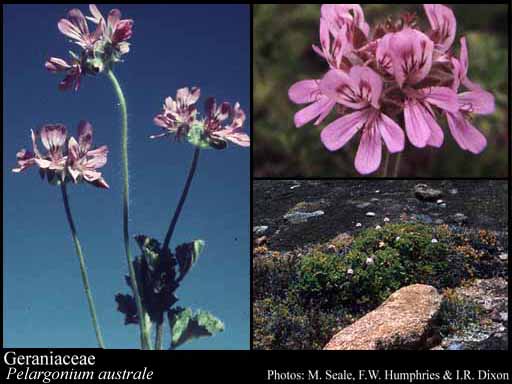- Reference
- Gen.Pl. [Jussieu] 268 (1789)
- Name Status
- Current

Scientific Description
Common name. Geranium Family.
Habit and leaf form. Herbs (usually), or shrubs; bearing essential oils. ‘Normal’ plants, or switch-plants. Plants succulent (rarely — e.g. Sarcocaulon, with fleshy stems), or non-succulent. Shrubs leptocaul, or pachycaul. Mesophytic, or xerophytic. Leaves alternate (the upper, often), or opposite (the lower, usually); petiolate; non-sheathing; gland-dotted, or not gland-dotted; aromatic (often, via capitate glands), or without marked odour; simple, or compound; when compound palmate (usually), or pinnate (rarely). Leaf blades when simple, dissected; when simple palmately lobed (usually), or pinnatifid (rarely); pinnately veined (rarely), or palmately veined (usually). Leaves usually with stipules. Stipules interpetiolar, or intrapetiolar (usually twinned at the base of the petiole); scaly, or leafy. Leaves without a persistent basal meristem. Stem anatomy. Nodes tri-lacunar. Secondary thickening absent, or developing from a conventional cambial ring.
Reproductive type, pollination. Fertile flowers hermaphrodite. Unisexual flowers absent. Plants hermaphrodite.
Inflorescence and flower features. Flowers solitary, or aggregated in ‘inflorescences’ (usually); in cymes, or in umbels. Inflorescences terminal, or axillary, or leaf-opposed; often pedunculate, usually consisting of paired flowers or umbels; with involucral bracts (commonly), or without involucral bracts. Flowers bracteolate; small, or medium-sized; regular to somewhat irregular. The floral asymmetry involving the perianth and involving the androecium (Pelargonium). Flowers usually 5 merous; cyclic; tetracyclic to polycyclic. Free hypanthium absent. Hypogynous disk present (usually), or absent (Pelargonium); of separate members (alternating with C, around A). Perianth with distinct calyx and corolla (usually), or sepaline (corolla sometimes missing); 5, or (7–)10; 2 -whorled (usually), or 1 -whorled; isomerous (usually), or anisomerous. Calyx 5; 1 -whorled; polysepalous, or gamosepalous (sometimes basally connate, or forming a lobed tube); imbricate (with valvate tips); regular, or unequal but not bilabiate; basally appendaged (Pelargonium, where the posterior member is prolonged into a tube adnate to the peduncle), or neither appendaged nor spurred; persistent; with the median member posterior. Corolla (2–)5; 1 -whorled; polypetalous; imbricate, or contorted (rarely); unequal but not bilabiate, or regular; deciduous (caducous). Petals clawed. Androecium 5, or 10, or 15 (1, 2 or 3 times C). Androecial members branched (rarely), or unbranched. Androecial sequence determinable, or not determinable. Androecial members when many, maturing centripetally; all equal to markedly unequal; coherent; 1 - adelphous (basally connate), or 5 - adelphous (rarely, with five triandrous bundles). The androecial groups when present, opposite the petals. Androecial members (1–)2(–3) -whorled. Androecium exclusively of fertile stamens, or including staminodes. Staminodes when present, 1–5 (some or all of the outer whorl). Stamens 5, or 10, or 15; isomerous with the perianth, or diplostemonous (usually), or triplostemonous; alternisepalous (obdiplostemonous when more than one whorl). Anthers dorsifixed; usually versatile; dehiscing via longitudinal slits; introrse; tetrasporangiate. Gynoecium 5 carpelled. The pistil 5 celled. Gynoecium syncarpous; synstylovarious; superior. Ovary plurilocular; 5 locular. Styles 1 (with an elongating, persistent column); attenuate from the ovary; apical. Stigmas 5; dry type; papillate; Group II type. Placentation axile. Ovules 1 per locule, or 2 per locule; pendulous, or ascending; usually epitropous; usually with ventral raphe; usually superposed; anatropous to campylotropous.
Fruit and seed features. Fruit non-fleshy; a schizocarp. Mericarps 5 (1-seeded, separating acropetally from the central ‘beak’, each taking a strip from the style to acquire a usually hygroscopically active awn). Seeds endospermic (scantily), or non-endospermic; exotegmic. Cotyledons 2. Embryo chlorophyllous (3/14); straight, or curved to bent. Seedling. Germination phanerocotylar.
Physiology, biochemistry. Aluminium accumulation not found. Photosynthetic pathway: C3 and CAM.
Special features. Non-mangrove species.
Geography, cytology, number of species. World distribution: cosmopolitan. X = 7–14. 750 species.
Keys
Western Australian Genera and Families of Flowering Plants — an interactive key
T.D. Macfarlane, L. Watson, N.G. Marchant